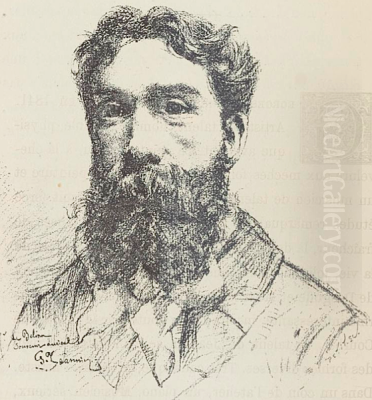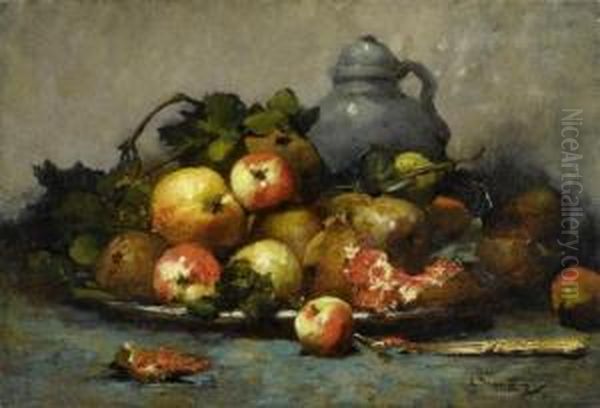
Georges Jeannin stands as a significant figure in late 19th and early 20th-century French art, celebrated primarily for his exquisite floral still life paintings. Born in Paris in 1841, he navigated the vibrant and competitive art world of his time, establishing a reputation for technical skill and a deep appreciation for the beauty of nature, particularly flowers. His long career, spanning from his debut in the late 1860s until his death in 1925, saw him achieve considerable success and recognition both within France and internationally.
Early Career and Artistic Beginnings
Georges Jeannin's artistic journey began in Paris, the epicenter of the art world during his formative years. He received his training under the guidance of Vincelet, an artist who helped shape his foundational skills. Jeannin's official entry into the Parisian art scene occurred in 1868 when he first exhibited his work at the prestigious Paris Salon. This marked the beginning of a long and consistent presence at the Salon, a critical venue for artists seeking recognition and patronage.
His early participation in the Salon indicated his ambition and his alignment with the established art system of the time. The Salon was the primary platform for artists to showcase their talents, gain critical notice, and attract buyers. Jeannin's regular acceptance into the Salon exhibitions throughout his career underscores the consistent quality and appeal of his work to the juries and the public alike.
The Specialization in Floral Still Life
While the provided texts suggest an interest in depicting scenes of modern life, Georges Jeannin became most renowned for his mastery of floral still life painting. He emerged as one of France's most popular and successful painters specializing in this genre. His canvases often featured lush arrangements of roses, his favored subject, rendered with remarkable detail and sensitivity to color and light. Works such as Vase of Roses (1921) and Roses in a Vase (1917) exemplify his dedication to capturing the delicate textures and vibrant hues of flowers.

His skill in this area was widely acknowledged. The French government itself became a significant patron, purchasing several of his works over the years. This official endorsement not only provided financial stability but also cemented his reputation as a leading artist in his field. His paintings were sought after for their decorative qualities, fitting perfectly with the tastes of the burgeoning bourgeoisie who desired art that brought beauty and refinement into their homes.
Jeannin's dedication to floral painting led him to become a prominent member, and eventually the president, of the Société de Peintres de Fleurs (Society of Flower Painters). This role placed him at the forefront of artists dedicated to the genre, allowing him to influence and associate with peers who shared his passion. His leadership in this society highlights his esteemed position among fellow specialists.
Style, Technique, and Influences
Jeannin's style is characterized by a meticulous attention to detail and a realistic rendering of his subjects, particularly the flowers he so often painted. His technique showcased a sophisticated understanding of light, shadow, and texture, bringing his floral arrangements to life on the canvas. While primarily known for these traditional still lifes, some sources suggest he also engaged with themes of modern life, depicting scenes like departures, holidays, and markets.
This interest in contemporary scenes aligns with broader trends in French art during the latter half of the 19th century. The Impressionist movement, gaining prominence in the 1860s and 1870s, famously turned its attention to everyday life. Artists like Claude Monet, Pierre-Auguste Renoir, Edgar Degas, Camille Pissarro, Berthe Morisot, and Gustave Caillebotte revolutionized art by capturing fleeting moments of modern existence. While Jeannin may not be classified as an Impressionist himself, the era's focus on contemporary subjects perhaps influenced his choice of themes beyond still life, as suggested by the sources.
Interestingly, the sources mention that his work, including these depictions of modern life and his flower paintings, garnered praise from none other than Vincent van Gogh. Van Gogh, known for his expressive brushwork and intense emotional content, also painted flowers, most famously sunflowers. Any appreciation from such a pivotal figure, if historically accurate according to the source material, would indicate the perceived quality and perhaps the emotional resonance of Jeannin's art, even across different stylistic approaches. Another notable contemporary known for floral paintings was Henri Fantin-Latour, whose work provides a point of comparison in the genre during the same period.
Recognition and Official Acclaim

Georges Jeannin's career was marked by significant official recognition. His regular participation in the Paris Salon and the acquisition of his works by the French state were early indicators of his success. In 1878, he became a member of the Société des Artistes Français, further integrating him into the formal structures of the French art establishment. His works found places in various museums across France, ensuring their accessibility to the public.
A major milestone in his career was the collaboration with the artist A. Cesbron (or possibly Cesaroni, as sources slightly differ) on the decoration of the Salon de la Musique within the prestigious Paris City Hall (Hôtel de Ville). Participating in such a significant public commission was a considerable honor and demonstrated the high regard in which his artistic abilities were held. Public commissions like these were highly sought after and contributed significantly to an artist's reputation.
The pinnacle of his official recognition came in 1903 when he was awarded the Chevalier de la Légion d'honneur (Knight of the Legion of Honour). This is France's highest order of merit, and its bestowal upon Jeannin confirmed his status as a respected and accomplished artist who had made a significant contribution to French culture.
Contemporaries and Artistic Milieu
Jeannin worked during a dynamic period in French art history, surrounded by artists exploring diverse styles and subjects. His teacher was Vincelet. His collaborator on the Paris City Hall project was A. Cesbron. He interacted with international artists, including the American painter Abbott Fuller Graves (referred to variously as Abbott Abner Fuller or Abbott Fuller Lawrence in the source texts), who reportedly came to learn from him, indicating Jeannin's international draw.
The sources also place Jeannin in a context of comparison or potential competition with major figures, particularly within the realm of still life or related genres. These include Edgar Degas, known for his depictions of modern life and occasional still lifes; Henri Matisse, a master of color whose work included still lifes; Henri Rousseau, the post-impressionist known for his naive style, including floral subjects; and Vincent van Gogh, whose powerful still lifes, especially of flowers, have become iconic.
Other contemporaries mentioned in the context of the era include Eugène Claude and Henri-Lucien Moreau. The broader artistic landscape also included Impressionists like Monet and Renoir, who often painted flowers, and other Salon painters who specialized in various genres. This rich environment meant that artists like Jeannin were constantly engaging with, reacting to, or differentiating themselves from a wide array of artistic approaches and talents. His success in carving out a niche as a premier flower painter amidst such company speaks to his skill and the appeal of his work. Figures like Alfred Sisley and Gustave Caillebotte were also prominent during parts of his active career.
Influence and Legacy
Georges Jeannin's influence is most pronounced within the realm of still life painting. His technical proficiency and dedication to capturing the beauty of flowers set a high standard. His success demonstrated the continued viability and appeal of specialized genres even during a period often defined by avant-garde movements. His ability to attract students, such as Abbott Fuller Graves, shows that his methods and style were deemed worthy of study.
His paintings satisfied a significant market demand, particularly from the middle and upper classes seeking refined decorations for their homes. In this sense, his work reflects the social and cultural tastes of the Belle Époque and the early 20th century. The enduring appeal of his art is evidenced by the fact that his paintings continue to be collected and appear at auction houses. The mention of a work like Still Life Fruit being sold in 2024 indicates a persistent, albeit perhaps modest, market interest.
While perhaps not as revolutionary as some of his contemporaries like Monet or Degas, Jeannin holds a secure place in art history as a master of floral painting. He excelled within his chosen specialty, achieving widespread recognition, official honors, and a lasting reputation for creating works of enduring beauty and technical excellence. His contribution lies in his consistent production of high-quality art that celebrated the natural world and brought aesthetic pleasure to many.
Conclusion
Georges Jeannin's life (1841-1925) spanned a transformative period in art, yet he remained largely dedicated to the meticulous and beautiful rendering of floral still lifes. From his training under Vincelet and debut at the Paris Salon to receiving the Legion of Honour and influencing artists from abroad, his career was one of consistent achievement and recognition. Remembered primarily for his roses, painted with sensitivity and skill, his work found favor with the French government, private collectors, and even drew praise from figures like Van Gogh, according to the sources reviewed. As a leading member and president of the Society of Flower Painters, and a contributor to major public decorations, Jeannin solidified his position as a significant specialist painter within the rich tapestry of French art. His legacy endures through his paintings, which continue to be appreciated for their elegance and masterful execution.